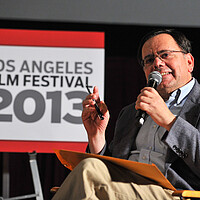Pretty in pink: In tonally uneven ‘Barbie,’ Robbie shines
Loading...
Having previewed the giddy, eye-poppingly pink trailer for “Barbie,” I approached the film with some trepidation. The Mattel doll was not a fixture of my childhood. Davy Crockett was my Barbie. But I still remember how ecstatic my niece was when gifted her very own Western Barbie. And I have rarely spoken to an adult woman who doesn’t harbor either a deep nostalgia or a deep distaste – sometimes both at once – for the doll.
So what to make of the movie? The advance word was: If you love Barbie, you’ll love it, and if you hate Barbie, you’ll love it. Isn’t this another way of saying the movie doesn’t really stand for anything? More likely, this is just a canny piece of commercial calculation: Placate both sides.
As it turns out, “Barbie” – starring Margot Robbie in the title role and Ryan Gosling as Barbie’s sort of boyfriend Ken – does indeed take a stand. In fact, it takes many stands. Directed by Greta Gerwig, whose last film was the commendable “Little Women,” and co-written with her partner, Noah Baumbach, it’s both a flippy romp and a feminist outcry in shades of pastel pink. It’s a movie knowingly at odds with itself, and the disequilibrium, for all the film’s high cheer, sits uneasily on the screen.
Why We Wrote This
A story focused on“Barbie” is both a flippy romp and a feminist outcry in shades of pastel pink. As enjoyable as the film can be, it also proves one thing: Even in Barbie Land, you can’t have it both ways.
The movie pays tribute to Barbie’s iconic place in the zeitgeist since the doll’s creation in 1959. (The doll reportedly rakes in $1.5 billion annually for Mattel, which hopes to create a movie wing to rival Marvel’s). At the same time, the filmmakers want us to know that Barbie is more than just a cute doll. In all her many incarnations – from homemaker to CEO to astronaut – she is meant to stand in for a woman’s freedom to be whoever she wants to be. In “Barbie,” enemy No. 1 is the patriarchy. And Ken becomes chief culprit.
When we first are introduced to Barbie Land, everything is dollhouse perfect. Every great day is like every other, all the Barbies are sparkling and chipper, and the Kens in this world are their rivalrous, doe-eyed admirers. These early scenes, including several of the film’s more rousing musical numbers, have a “Pee-wee’s Big Adventure”-like nuttiness but without the oddball undertone. There’s a kinetic jubilation to these pink plastic tableaux. Watching Barbie dolls come to life is a whole lot more joyful than, say, seeing Transformers rumble onto the big screen.
But it soon becomes clear in Barbie Land that something un-Barbie-like is going on with Barbie. She suddenly wonders aloud during a girls’ danceathon if anybody “ever thinks about dying.” Her perpetually raised heels fall flat. She develops cellulite. In order to restore her stereotypical pristineness, she must journey into the real world, with Ken in tow, and set things right.
The real world here is Southern California, with its sunny beaches and proximity to Mattel headquarters. And in this world, women are shown to be subservient to men, much to the puzzlement of Barbie and the pleased astonishment of Ken. Upon returning to Barbie Land, he proceeds to turn it into Ken-Dom, with his band of bros ruling the roost. Barbie Land must be rescued from all this toxicity and restored to a happier place where life is finally recognized for all its inherent confusions.
Up to a point, this preachiness is redeemed by the film’s spiritedness and by the ardent performances of Robbie and Gosling. It was Robbie who initiated this project, and to say she is perfectly cast is to state the obvious. But she never condescends to her character or winks at the audience to let us know she’s too smart to be taken in by Barbie. She’s so funny in the role, and so touching, because she’s so respectful of Barbie’s wonderment.
She’s well matched with Gosling, whose ongoing bewilderments as Ken are instantly relatable. Gerwig has said in interviews that with Ken she was trying for a cross between, among others, Marlon Brando and Gene Wilder. In his finer befuddled moments, that’s indeed how Gosling comes across.
Gerwig at her best has a true populist feel for how to give the audience pleasure. That’s why her decision to play to all sides here periodically throws the film tonally out of whack. When, for example, an outraged real-world teen (played by Ariana Greenblatt) calls out Barbie for being a “fascist,” or when her mother (America Ferrera), a Mattel employee, delivers a scathing rant about the woes of womanhood, I felt, not for the first time, that the movie crossed the line.
I sympathize with Gerwig’s attempt to thread the needle, but, as enjoyable as “Barbie” can be, it also proves one thing: Even in Barbie Land, you can’t have it both ways.
Peter Rainer is the Monitor’s film critic. “Barbie” is rated PG-13 for suggestive references and brief language.










